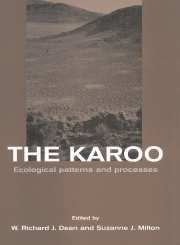Book contents
- Frontmatter
- Contents
- List of contributors
- Foreword
- Preface
- Acknowledgements
- Part one Biogeographic patterns and the driving variables
- Part two Form and function
- 6 Form and function in perennial plants
- 7 Functional aspects of short-lived plants
- 8 Plant reproductive ecology
- 9 Animal form and function
- 10 Animal foraging and food
- Part three Dynamics
- Part four Human impacts
- Part five Comparisons
- References
- Index
10 - Animal foraging and food
Published online by Cambridge University Press: 23 December 2009
- Frontmatter
- Contents
- List of contributors
- Foreword
- Preface
- Acknowledgements
- Part one Biogeographic patterns and the driving variables
- Part two Form and function
- 6 Form and function in perennial plants
- 7 Functional aspects of short-lived plants
- 8 Plant reproductive ecology
- 9 Animal form and function
- 10 Animal foraging and food
- Part three Dynamics
- Part four Human impacts
- Part five Comparisons
- References
- Index
Summary
Introduction
Resources in the karoo, desert, and the arid savanna are generally patchy in time and space, lacking the seasonality typical of more mesic winter and summer rainfall biomes. The southern and western parts of the karoo are poor in species and abundance of grasses (Acocks, 1953; Gibbs Russell et al., 1990), and lack the large grazing herbivores of the grasslands and mesic savannas (Skead, 1980, 1987) or granivorous rodents characteristic of northernhemisphere arid systems (Abramsky, 1983; Kerley, 1991). Plants bearing juicy fruits are spatially restricted (mainly to drainage lines), so this resource is only available to animals of these habitats, or animals able to move economically between drainage lines (Acocks, 1976). Seeds are abundant but patchy, so granivores must either move between patches, as the granivorous birds do, or store seeds during a time of plenty, as the ants do. Small mammals are not abundant (Kerley, 1992a) and, in general, carnivores tend to take a wider range of prey sizes and species in the karoo than they do elsewhere (Palmer and Fairall, 1988; Boshoff et al., 1990). Even such species as black eagle Aquila verreauxii, thought to be relatively stenophagous, take a wide range of prey species (Boshoff et al., 1991). Below-ground, however, there is an abundance of food, and, for those animals that are fossorial, or are able to dig into hard soils, there are rich rewards in the form of underground plant parts as well as invertebrate and vertebrate prey.
Food resources for animals in the karoo can be classified along an availability (or predictability) gradient as dependable, seasonal or unpredictably scattered in time and space.
- Type
- Chapter
- Information
- The KarooEcological Patterns and Processes, pp. 164 - 178Publisher: Cambridge University PressPrint publication year: 1999
- 4
- Cited by

